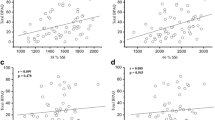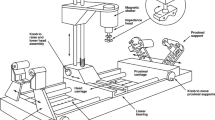Abstract
The aim of this cross-sectional study was to investigate whether physical activity and local arterial thickening may affect bone metabolism. To analyze the effects of physical activity and atherosclerosis on bone in healthy Japanese people, health-related quality of life (HRQL) and local arterial thickening were assessed by means of the MedicalOutcomes Study 36-item Short Form (SF-36), and intimal-medial thickness (IMT) in common carotid artery (CA) and femoral artery (FA), respectively. Bone mineral density (BMD) in lumbar spine was measured by dual X-ray absorptiometry and the osteo-sono assessment index (OSI) of the calcaneus by ultrasound. Healthy subjects (106 male and 154 female) were recruited from those who participated in a local health check program at the Osaka City University Hospital. A significant correlation existed between lumbar spine BMD and calcaneus OSI (r=0.551, P<0.0001). Among various scores in SF-36, only physical functioning score correlated weakly but significantly in a positive manner with lumbar spine BMD (ρ=0.156, P=0.0147) and calcaneus OSI (ρ=0.190, P=0.0024). Lumbar spine BMD correlated negatively with FA IMT (ρ=−0.191, P=0.0027) whereas calcaneus OSI with FA IMT (ρ=−0.199, P=0.0014). Multiple regression analyses revealed a significant association between FA IMT and calcaneus OSI, whereas lumbar spine BMD did not correlate significantly with FA or CA IMT. When subjects were restricted to female, FA IMT, but not CA IMT, still showed tendency against independent factors negatively associated with calcaneus OSI. Furthermore, lumbar spine BMD, but not calcaneus OSI, was weakly but significantly associated with increased physical functioning score independently. In conclusion, it was suggested that physical activity may affect bone strength in lumbar spine and calcaneus and that FA IMT might be a significant determinant of bone strength in calcaneus, but not in lumbar spine, in healthy Japanese subjects.




Similar content being viewed by others

References
Vogt MT, Cauley JA, Kuller LH et al. (1997) Bone mineral density and blood flow to the lower extremities: the study of osteoporotic fractures. J Bone Miner Res 12:283–289
Adachi JD, Loannidis G, Berger C et al. (2001) Canadian Multicentre Osteoporosis Study (CaMos) Research Group. The influence of osteoporotic fractures on health-related quality of life in community-dwelling men and women across Canada. Osteoporos Int 12: 903–908
Salonen R, Salonen JT (1990) Progression of carotid atherosclerosis and its determinants: a population-based ultrasonography study. Atherosclerosis 81:33–40
Kawamori R, Yamasaki Y, Matsushima H et al. (1992) Prevalence of carotid atherosclerosis in diabetic patients: ultrasound high-resolution B-mode imaging on carotid arteries. Diabetes Care 15:1290–1294
Yamasaki Y, Kawamori R, Matsushima H et al. (1994) Atherosclerosis in carotid artery of young IDDM patients monitored by ultrasound high-resolution B-mode imaging. Diabetes 43:634–639
Wofford J, Kahl F, Howard G et al. (1991) Relation of extent of extracranial carotid artery atherosclerosis as measured by B-mode ultrasound to the extent of coronary atherosclerosis. Arterioscler Thromb 11:1786–1794
Lekakis JP, Papamichael CM, Cimponeriu AT et al. (2000) Atherosclerotic changes of extracoronary arteries are associated with the extent of coronary atherosclerosis. Am J Cardiol 85:949–952
Simons PC, Algra A, Bots ML et al. (1999) Common carotid intima-media thickness and arterial stiffness: indicators of cardiovasucular risk in high-risk patients. The SMART Study (Second Manifestation of ARTerial disease). Circulation 100:951–957
Taniwaki H, Shoji T, Emoto M et al. (2001) Femoral artery wall thickness and stiffness in evaluation of peripheral vascular disease in type 2 diabetes mellitus. Atherosclerosis 158:207–214
Neville CE, Murray LJ, Boreham CA et al. (2002) Relationship between physical activity and bone mineral status in young adults: the Northern Ireland Young Hearts Projects. Bone 30:792–798
Lehtonen-Veromaa M, Mottonenn T, Nuotio I et al. (2000) Influence of physical activity on ultrasound and dual-energy X-ray absorptiometry bone measurements in peripubertal girls: a cross-sectional study. Calcif Tissue Int 66:248–254
Kumeda Y, Inaba M, Goto H et al. (2002) Increased thickness of the arterial intima-media detected by ultrasonography in patients with rheumatoid arthritis. Arthr Rheum 46:1489–1497
Pincus T, Summey JA, Soraci SA Jr et al. (1983) Assessment of patient satisfaction in activities of daily living using a modified Stanford Health Assessment Questionnaire. Arthr Rheum 26:1346–1353
Inaba M, Nagata M, Goto H et al. (2003) Preferential reductions of paraarticular trabecular bone component in ultradistal radius and of calcaneus ultrasonography in early-stage rheumatoid arthritis. Osteoporos Int 14:683–687
Ware JE (1993) SF-36 Health Survey Manual and Interpretation Guide. The Health Institute, New England Medical Center, Boston, Mass.
Fukuhara S, Bito S, Green J et al. (1998) Translation, adaptation, and validation of the SF-36 Health Survey for use in Japan. J Clin Epidemiol 51:1037–1044
Fukuhara S, Ware J E, Kosinski M et al. (1998) Psychometric and clinical tests of validity of the Japanese SF-36 Health Survey for use in Japan. J Clin Epidemiol 51:1045–1053
Ware JE, Kosinski M, Keller SD (1994) SF-36 Physical and Mental Health Summary Scales: a user’s manual. The Health Institute, New England Medical Centre, Boston, Mass.
Tosteson AN, Gabriel SE, Grove MR et al. (2001) Impact of hip and vertebral fractures on quality-adjusted life years. Osteoporos Int 12:1042–1049
Inaba M, Nishizawa Y, Mita K et al. (1999) Poor glycemic control impairs the response of biochemical parameters of bone formation and resorption to exogenous 1,25-dihydroxyvitamin D3 in patients with type 2 diabetes. Osteoporos Int 9:525–531
Nagata-Sakurai M, Inaba M, Goto H et al. (2003) Importance of inflammation and bone resorption in an increase of arterial intima-media thickness (IMT) in patients with rheumatoid arthritis (RA). Arthr Rheum 48:3061–3067
Cheng S, Njeh CF, Fan B et al. (2002) Influence of region of interest and bone size on calcaneus BMD: implications for the accuracy of quantitative ultrasound assessments at the calcaneus. Br J Radiol 75:59–68
Tsuda-Futami E, Hans D, Njeh CF et al. (1999) An evaluation of a new gel-coupled ultrasound device for the quantitative assessment of bone. Br J Radiol 72:691–700
Nagasaki T, Inaba M, Henmi Y et al. (2003) Decrease in carotid intima-media thickness in hypothyroid patients after normalization of thyroid function. Clin Endocrinol 59:607–612
Kawagishi T, Nishizawa Y, Konishi T et al. (1995) High-resolution B-mode ultrasonography in evaluation of atherosclerosis in uremia. Kidney Int 48:820–826
Hirai T, Sasayama S, Kawasaki T et al. (1989) Stiffness of systemic arteries in patients with myocardial infarction: a noninvasive method to predict severity of atherosclerosis. Circulation 80:78–86
Hosoi M, Nishizawa Y, Kogawa K et al. (1996) Angiotensin-converting enzyme gene polymorphism is associated with carotid arterial wall thickness in non-insulin-dependent diabetes patients. Circulation 94:704–707
Poli A, Tremoli E, Colombo A et al. (1988) Ultrasonographic measurement of the common carotid artery wall thickness in hypercholesterolemic patients: a new model for the quantitation and follow-up of preclinical atherosclerosis in living human subjects. Atherosclerosis 70:253–261
Bland JM, Altman DG (1986) Statistical methods for assessing agreement between two methods of clinical measurement. Lancet 1:307–310
Friedlander AL, Genant HK, Sadowsky S et al. (1995) A two-year program of aerobics and weight training enhances bone mineral density of young women. J Bone Miner Res 10:574–585
Shigematsu T, Miyamoto A, Mukai C et al. (1997) Changes in bone and calcium metabolism with space flight. Osteoporos Int 7:S63–7
Boot AM, de Ridder MAJ, Pols HA et al. (1997) Bone mineral density in children and adolescents: relation to puberty, calcium intake, and physical activity. J Clin Endocrinol Metab 82:57–62
Damilakis J, Perisinakis K, Kontakis et al. (1999) Effect of lifetime occupational physical activity on indices of bone mineral status in healthy postmenopausal women. Calcif Tissue Int 64:112–116
Daly RM, Rich PA, Klein R (1997) Influence of high impact loading on ultrasound bone measurements in children: a cross-sectional study. Calcif Tissue Int 60:401–404
Lappe JM, Recker RR, Weidenbusch D (1998) Influence of activity level on patellar ultrasound transmission velocity in children. Osteoporos Int 8:39–46
Hoshino H, Kushida K, Yamazaki K et al. (1996) Effect of physical activity as a caddie on ultrasound measurements of the os calcis: a cross-sectional comparison. J Bone Miner Res 11:412–418
Okabe R, Inaba M, Sakai S et al. (2004) Enhanced atheroscleosis in paretic lower in the patients with hemiparesis. Clin Sci (Lond) 166:613–618
Laroche M, Pouilles JM, Ribot C et al. (1994) Comparison of the bone mineral content of the lower limbs in men with ischemic atherosclerotic disease. Clin Rheum 13:611–614
Laroche M, Barbier A, Ludot I et al. (1996) Effect of ovariectmy on intraosseous vascularization and bone remodelling in rats: action of tiludronate. Osteoporos Int 6:127–129
Reeve J, Arlot M, Wootton R et al. (1988) Skeletal blood flow, iliac histomorphometry and strontium kinetics in osteoporosis: a relationship between blood flow and corrected apposition rate. J Clin Endcrinol Metab 66:1124–1131
Burkhardt R, Barti R, Frisch B et al. (1984) The structural relationship of bone forming and endothelial cells of the bone marrow. In: Bone circulation. Williams and Wilkins, Baltimore, pp 2–14
Author information
Authors and Affiliations
Corresponding author
Rights and permissions
About this article
Cite this article
Yamada, S., Inaba, M., Goto, H. et al. Significance of intima-media thickness in femoral artery in the determination of calcaneus osteo-sono index but not of lumbar spine bone mass in healthy Japanese people. Osteoporos Int 16, 64–70 (2005). https://doi.org/10.1007/s00198-004-1642-1
Received:
Accepted:
Published:
Issue Date:
DOI: https://doi.org/10.1007/s00198-004-1642-1



